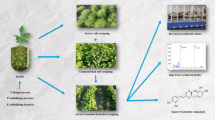Abstract
This study investigated the effects of different crop** patterns and arbuscular mycorrhizal fungi (AMF) inoculation on the productivity of kidney bean and the essence quantity and quality of lemon balm. The crop** patterns included kidney bean monoculture (KBm), lemon balm monoculture (LBm), and additive intercrop** ratios of 100% lemon balm + 15% kidney bean (LB/15 KB), 100% lemon balm + 30% kidney bean (LB/30 KB), 100% lemon balm + 45% kidney bean (LB/45 KB), 100% lemon balm + 60% kidney bean (LB/60 KB), with or without AMF inoculation. Monoculture produced the highest dry matter yield of lemon balm [139.1 g m–2 (first harvest) and 121.0 g m–2 (second harvest)] and seed yield of kidney bean (1315 kg ha–1). AMF inoculation increased the dry matter yields of lemon balm by 9.6% and 10.9% (first and second harvests, respectively) and seed yield of kidney bean by 41.8%. The LB/45 KB intercrop** ratio produced the highest essence content of lemon balm [0.17% (first harvest) and 0.16% (second harvest)], which did not significantly differ from those in LB/30 KB. Interestingly, AMF inoculation enhanced essence productivity by 33.3% in the first harvest and 21.4% in the second harvest. For both harvests, the GC–MS analyses identified 19 constituents in the lemon balm essence, with the major constituents being citronella, geranial, neral, trans-caryophyllene, and caryophyllene oxide. The LB/45 KB with AMF treatment produced the highest citronella content in both harvests. Concentrations of N, P, and K in most of intercrop** patterns increased over the monocultures. We conclude that intercrop** with AMF inoculation could be an agroecological strategy for improving the essence content, yield, and quality of lemon balm.








Similar content being viewed by others
References
Amani Machiani M, Javanmard A, Morshedloo MR, Maggi F (2018) Evaluation of yield, essence content and compositions of peppermint (Mentha piperita L.) intercropped with faba bean (Vicia faba L.). J Clean Prod 171:529–537. https://doi.org/10.1016/j.jclepro.2017.10.062
Amani Machiani M, Javanmard A, Habibi Machiani R, Sadeghpour A (2022) Arbuscular mycorrhizal fungi and changes in primary and secondary metabolites. Plants 11(17):2183. https://doi.org/10.3390/plants11172183
Amani Machiani M, Javanmard A, Morshedloo MR, Aghaee A, Maggi F (2021a) Funneliformis mosseae inoculation under water deficit stress improves the yield and phytochemical characteristics of thyme in intercrop** with soybean. Sci Rep 11:15279. https://doi.org/10.1038/s41598-021-94681-9
Amani Machiani M, Javanmard A, Morshedloo MR, Janmohammadi M, Maggi F (2021b) Funneliformis mosseae application improves the oil quantity and quality and eco-physiological characteristics of soybean (Glycine max L.) under water stress conditions. J Soil Sci Plant Nutr 21(4):3076–3090. https://doi.org/10.1007/s42729-021-00590-1
Battini F, Grønlund M, Agnolucci M, Giovannetti M, Jakobsen I (2017) Facilitation of phosphorus uptake in maize plants by mycorrhizosphere bacteria article. Sci Rep 7:1–11. https://doi.org/10.1038/s41598-017-04959-0
Begum N, Qin C, Ahanger MA, Raza S, Khan MI, Ashraf M, Ahmed N, Zhang L (2019) Role of arbuscular mycorrhizal fungi in plant growth regulation: implications in abiotic stress tolerance. Front Plant Sci 10:1–15. https://doi.org/10.3389/fpls.2019.01068
Calsamiglia S, Busquet M, Cardozo PW, Castillejos L, Ferret A (2007) Invited review: essential oils as modifiers of rumen microbial fermentation. J Dairy Sci 90(6):2580–2595. https://doi.org/10.3168/jds.2006-644
Campion A, Oury FX, Heumez E, Rolland B (2020) Conventional versus organic farming systems: dissecting comparisons to improve cereal organic breeding strategies. Org Agric 10:63–74. https://doi.org/10.1007/s13165-019-00249-3
de Assis RMA, Carneiro JJ, Medeiros APR, de Carvalho AA, da Cunha Honorato A, Carneiro MAC, Bertolucci SKV, Pinto JEBP (2020) Arbuscular mycorrhizal fungi and organic manure enhance growth and accumulation of citral, total phenols, and flavonoids in Melissa officinalis L. Ind Crops Prod 158:112981. https://doi.org/10.1016/j.indcrop.2020.112981
da Cruz RMS, da Cruz GLS, Dragunski DC, Junior ACG, Alberton O, de Souza SGH (2019) Inoculation with arbuscular mycorrhizal fungi alters content and composition of essence of sage (Salvia officinalis) under different phosphorous levels. Aust J Crop Sci 13(10):1617–1624. https://doi.org/10.21475/ajcs.19.13.10.p1834
Draginic N, Jakovljevic V, Andjic M, Jeremic J, Srejovic I, Rankovic M, Tomovic M, Nikolic Turnic T, Svistunov A, Bolevich S, Milosavljevic I (2021) Melissa officinalis L. as a nutritional strategy for cardioprotection. Front Physiol. https://doi.org/10.3389/fphys.2021.661778
Duchene O, Vian JF, Celette F (2017) Intercrop** with legume for agroecological crop** systems: complementarity and facilitation processes and the importance of soil microorganisms. A Review Agric Ecosyst Environ 240:148–161. https://doi.org/10.1016/j.agee.2017.02.019
Eulenstein F, Tauschke M, Behrendt A, Monk J, Schindler U, Lana MA, Monk S (2017) The application of mycorrhizal fungi and organic fertilisers in horticultural potting soils to improve water use efficiency of crops. Horticulturae 3(1):1–8. https://doi.org/10.3390/horticulturae3010008
Faridvand S, Rezaei-Chiyaneh E, Battaglia ML, Gitari HI, Raza MA, Siddique KHM (2022) Application of bio and chemical fertilizers improves yield, and essential oil quantity and quality of Moldavian balm (Dracocephalum moldavica L.) intercropped with mung bean (Vigna radiata L.). Food Energy Secur 11:319. https://doi.org/10.1002/fes3.319
Fotohi Chiyaneh S, Rezaei-Chiyaneh E, Amirnia R, Keshavarz Afshar R, Siddique KHM (2022) Changes in the essential oil, fixed oil constituents, and phenolic compounds of ajowan and fenugreek in intercrop** with pea affected by fertilizer sources. Ind Crops Prod 178:114587. https://doi.org/10.1016/j.indcrop.2022.114587
Ghaderimokri L, Rezaei-Chiyaneh E, Ghiyasi M, Gheshlaghi M, Battaglia ML, Siddique KHM (2022) Application of humic acid and biofertilizers changes oil and phenolic compounds of fennel and fenugreek in intercrop** systems. Sci Rep 12:5946. https://doi.org/10.1038/s41598-022-09645-4
Giovannetti M, Mosse B (1980) An evaluation of techniques for measuring vesicular arbuscular mycorrhizal infection in roots. New Phytol. 84:489–500. https://doi.org/10.1111/j.1469-8137.1980.tb04556.x
Hashem A, Kumar A, Al-Dbass AM, Alqarawi AA, Al-Arjani ABF, Singh G, Farooq M (2019) Arbuscular mycorrhizal fungi and biochar improves drought tolerance in chickpea. Saudi J Biol Sci 26(3):614–624. https://doi.org/10.1016/j.sjbs.2018.11.005
Hassiotis CN, Ntana F, Lazari DM, Poulios S, Vlachonasios KE (2014) Environmental and developmental factors affect essence production and quality of Lavandula angustifolia during flowering period. Ind Crops Prod 62:359–366. https://doi.org/10.1016/j.indcrop.2014.08.048
Ilić ZS, Milenković L, Tmušić N, Stanojević L, Stanojević J, Cvetković D (2022) Essential oils content, composition and antioxidant activity of lemon balm, mint and sweet basil from Serbia. LWT 153:112210. https://doi.org/10.1016/j.lwt.2021.112210
Jones JB (1972) Micronutrients in Agriculture. Society America, Madison, Soil Sci
Kaur S, Suseela V (2020) Unraveling arbuscular mycorrhiza-induced changes in plant primary and secondary metabolome. Metabolites 10:335–365. https://doi.org/10.3390/metabo10080335
Li YL, ** ZX, Luo GY, Chen C, Sun ZS, Wang XY (2022) Effects of arbuscular mycorrhizal fungi inoculation on non-structural carbohydrate contents and C:N:P stoichiometry of Heptacodium miconioides under drought stress. J Appl Ecol 33:963–971. https://doi.org/10.13287/j.1001-9332.202204.014
Maitra S, Hossain A, Brestic M, Skalicky M, Ondrisik P, Gitari H, Brahmachari K, Shankar T, Bhadra P, Palai JB, Jena J, Bhattacharya U, Duvvada SK, Lalichetti S, Sairam M (2021) Intercrop**-A low input agricultural strategy for food and environmental security. Agronomy 11:343–371. https://doi.org/10.3390/agronomy11020343
Martin-Guay MO, Paquette A, Dupras J, Rivest D (2018) The new green revolution: sustainable intensification of agriculture by intercrop**. Sci Total Environ 615:767–772. https://doi.org/10.1016/j.scitotenv.2017.10.024
Miraj S, Rafieian-Kopaei M, Kiani S (2017) Melissa officinalis L: a review study with an antioxidant prospective. J Evid Based Complementary Altern Med 22(3):385–394. https://doi.org/10.1177/2156587216663433
Mohammadzadeh V, Rezaei-Chiyaneh E, Mahdavikia H, Rahimi A, Gheshlaghi M, Leonardo Battaglia M, Harrison MT (2022) Effect of intercrop** and bio-fertilizer application on the nutrient uptake and productivity of mung bean and marjoram. Land 11:1825. https://doi.org/10.3390/land11101825
Mohasseli V, Farbood F, Moradi A (2020) Antioxidant defense and metabolic responses of lemon balm (Melissa officinalis L.) to Fe-nano-particles under reduced irrigation regimes. Ind Crops Prod 149:112338. https://doi.org/10.1016/j.indcrop.2020.112338
Namazi Y, Rezaei-Chiyaneh E, Siavash Moghaddam S, Leonardo Battaglia M (2022) The effects of microbial inoculation and intercrop** on yield and active ingredients of savory (Satureja hortensis L.) intercropped with common bean (Phaseolus vulgaris L.). Int J Environ Sci Technol https://doi.org/10.1007/s13762-022-04024-y
Phillips JM, Hayman DS (1970) Improved procedures for clearing roots and staining parasitic and vesicular arbuscular mycorrhizal fungi for rapid assessment of infection. Trans Br Mycol Soc 55:158–161. https://doi.org/10.1016/S0007-1536(70)80110-3
Plaza-Bonilla D, Nogué-Serra I, Raffaillac D, Canero-Martinez C, Justes E (2018) Carbon footprint of crop** systems with grain legumes and cover crops: a case-study in SW France. Agric Syst 167:92–102. https://doi.org/10.1016/j.agsy.2018.09.004
Rezaei-Chiyaneh E, Battaglia ML, Sadeghpour A, Shokrani F, Nasab ADM, Raza MA, von Cossel M (2021a) Optimizing intercrop** systems of black cumin (Nigella sativa L.) and fenugreek (Trigonella foenum-graecum L.) through inoculation with bacteria and mycorrhizal fungi. Adv Sustain Syst 2000269:1–14. https://doi.org/10.1002/adsu.202000269
Rezaei-Chiyaneh E, Jalilian J, Seyyedi SM, Barin M, Ebrahimian E, Keshavarz Afshar R (2021b) Isabgol (Plantago ovata) and lentil (Lens culinaris) intercrop response to arbuscular mycorrhizal fungi inoculation. Biol Agric Hortic 37:125–140. https://doi.org/10.1080/01448765.2021.1903556
Rezaei-Chiyaneh E, Mahdavikia H, Battaglia ML, Thomason WE, Caruso G (2021c) Intercrop** and fertilizer type impact seed productivity and secondary metabolites of dragon’s head and fenugreek. Sci Hortic (Amsterdam) 287:110277. https://doi.org/10.1016/j.scienta.2021.110277
Saad AM, Sitohy MZ, Ahmed AI, Rabie NA, Amin SA, Aboelenin SM, Soliman MM, El-Saadony MT (2021) Biochemical and functional characterization of kidney bean protein alcalase-hydrolysates and their preservative action on stored chicken meat. Molecules 26(15):4690. https://doi.org/10.3390/molecules26154690
Senoo K, Kaneko M, Taguchi R, Murata J, Santasup C, Tanaka A, Obata H (2002) Enhanced growth and nodule occupancy of red kidney bean and soybean inoculated with soil aggregate-based inoculant. Soil Sci Plant Nutr 48(2):251–259. https://doi.org/10.1080/00380768.2002.10409198
Strzemski M, Dzida K, Dresler S, Sowa I, Kurzepa J, Szymczak G, Wójciak M (2021) Nitrogen fertilisation decreases the yield of bioactive compounds in Carlina acaulis L. grown in the field. Ind Crops Prod 170:113698. https://doi.org/10.1016/j.indcrop.2021.113698
Tandon HLS, Cescas MP, Tyner EH (1968) An acid-free vanadate-molybdate reagent for the determination of total phosphorus in soils. Soil Sci Soc Am J 32:48–51. https://doi.org/10.2136/sssaj1968.03615995003200010012x
Thokchom SD, Gupta S, Kapoor R (2020) Arbuscular mycorrhiza augments essential oil composition and antioxidant properties of Ocimum tenuiflorum L. A popular green tea additive. Ind Crops Prod 153:112418. https://doi.org/10.1016/j.indcrop.2020.112418
Weisany W, Raei Y, Salmasi SZ, Sohrabi Y, Ghassemi-Golezani K (2016) Arbuscular mycorrhizal fungi induced changes in rhizosphere, essential oil and mineral nutrients uptake in dill/common bean intercrop** system. Ann Appl Biol 169(3):384–397. https://doi.org/10.1111/aab.12309
Zamani F, Amirnia R, Rezaei-Chiyaneh E, Gheshlaghi M, von Cossel M, Siddique KHM (2022) Optimizing essential oil, fatty acid profiles, and phenolic compounds of dragon’s head (Lallemantia iberica) intercropped with chickpea (Cicer arietinum L.) with biofertilizer inoculation under rainfed conditions in a semi-arid region. Arch Agron Soil Sci. https://doi.org/10.1080/03650340.2022.2105320
Zhao Y, Cartabia A, Lalaymia I, Declerck S (2022) Arbuscular mycorrhizal fungi and production of secondary metabolites in medicinal plants. Mycorrhiza 32:221–256. https://doi.org/10.1007/s00572-022-01079-0
Funding
This research did not receive any specific grant from funding agencies in the public, commercial, or not-for-profit sectors. Daniel Plaza-Bonilla is a Ramón y Cajal fellow (RYC-2018–024536-I), co-funded by MICIN/AEI/10.13039/501100011033 and European Social Fund.
Author information
Authors and Affiliations
Corresponding author
Ethics declarations
Conflict of interest
The authors declare that they have no conflict of interest.
Ethical approval
This article does not contain any studies with human participants or animals performed by any author.
Additional information
Editorial responsibility: Maryam Shabani.
Rights and permissions
Springer Nature or its licensor (e.g. a society or other partner) holds exclusive rights to this article under a publishing agreement with the author(s) or other rightsholder(s); author self-archiving of the accepted manuscript version of this article is solely governed by the terms of such publishing agreement and applicable law.
About this article
Cite this article
Qoreishi, E., Rezaei-Chiyaneh, E., Mahdavikia, H. et al. Lemon balm and kidney bean intercrop**: the potential for incorporating AMF for sustainable agricultural production. Int. J. Environ. Sci. Technol. 20, 6835–6848 (2023). https://doi.org/10.1007/s13762-023-04917-6
Received:
Revised:
Accepted:
Published:
Issue Date:
DOI: https://doi.org/10.1007/s13762-023-04917-6




